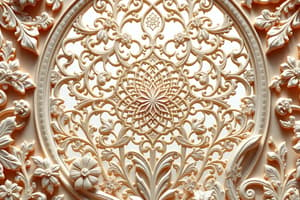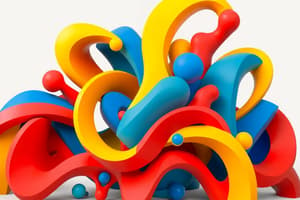Podcast
Questions and Answers
What is the most common 3D printing process in use as of 2020?
What is the most common 3D printing process in use as of 2020?
- Digital Light Processing (DLP)
- Selective Laser Sintering (SLS)
- Stereolithography (SLA)
- Fused Deposition Modeling (FDM) (correct)
Which industry is increasingly turning to 3D printing to reduce costs, improve fuel efficiency, and create complex shapes for jet engines?
Which industry is increasingly turning to 3D printing to reduce costs, improve fuel efficiency, and create complex shapes for jet engines?
- Automotive industry
- Medical industry
- Fashion industry
- Aviation industry (correct)
What is the ISO/ASTM standard that defines seven categories of additive manufacturing (AM) processes within its meaning?
What is the ISO/ASTM standard that defines seven categories of additive manufacturing (AM) processes within its meaning?
- ISO/ASTM52700-14
- ISO/ASTM52500-13
- ISO/ASTM52300-12
- ISO/ASTM52900-15 (correct)
Which technique involves the deposition of a binding adhesive agent onto layers of material, usually powdered?
Which technique involves the deposition of a binding adhesive agent onto layers of material, usually powdered?
What is the potential of 4D printing?
What is the potential of 4D printing?
What is one of the benefits of 3D printing?
What is one of the benefits of 3D printing?
What is the technique that melts or softens the material to produce the layers?
What is the technique that melts or softens the material to produce the layers?
Which industry is using 3D printing for the production of personalized formulations?
Which industry is using 3D printing for the production of personalized formulations?
What is the technique that uses photopolymerization primarily to produce a solid part from a liquid?
What is the technique that uses photopolymerization primarily to produce a solid part from a liquid?
Flashcards
3D Printing/Additive Manufacturing
3D Printing/Additive Manufacturing
The construction of a 3D object from a digital model by depositing, joining, or solidifying material layer by layer.
Additive Manufacturing (AM)
Additive Manufacturing (AM)
Synonymous with 3D printing, commonly used when referring to industrial end-use part production.
Fused Deposition Modeling (FDM)
Fused Deposition Modeling (FDM)
The most common 3D printing process, involving the extrusion of melted material layer by layer.
Agile Tooling
Agile Tooling
Signup and view all the flashcards
3D Printable Models
3D Printable Models
Signup and view all the flashcards
4D Printing
4D Printing
Signup and view all the flashcards
Powder Bed Fusion
Powder Bed Fusion
Signup and view all the flashcards
Binder Jetting
Binder Jetting
Signup and view all the flashcards
Cryogenic 3D Printing
Cryogenic 3D Printing
Signup and view all the flashcards
Study Notes
History and Terminology of 3D Printing/Additive Manufacturing
-
3D printing/additive manufacturing is the construction of a three-dimensional object from a digital 3D model.
-
The process involves material being deposited, joined, or solidified under computer control, typically layer by layer.
-
3D printing was initially considered suitable only for the production of functional or aesthetic prototypes, but it has since evolved to become a viable industrial-production technology.
-
One of the key advantages of 3D printing is the ability to produce complex shapes or geometries that would be otherwise infeasible to construct by hand.
-
Fused deposition modeling (FDM) is the most common 3D printing process in use as of 2020.
-
Additive manufacturing (AM) is a synonym for 3D printing and is commonly used in industrial end-use part production contexts.
-
Other terms used as synonyms or hypernyms include rapid prototyping and on-demand manufacturing.
-
The mental model of the previous industrial era involved long lead times for laborious tooling development, but agile tooling has introduced a cost-effective and high-quality method to quickly respond to customer and market needs.
-
The concept of 3D printing was first described in a 1945 short story by Murray Leinster.
-
Additive manufacturing equipment and materials were developed in the 1980s, with the first 3D printer costing upwards of $300,000.
-
The 1990s saw the development of metal sintering or melting AM processes, sacrificial and support materials, and new object geometries.
-
The Fused Deposition Modeling (FDM) printing process patents expired in 2009, leading to a new wave of companies developing commercial FDM 3D printers.The Evolution of 3D Printing: Benefits, Applications, and General Principles
-
The aviation industry is increasingly turning to 3D printing to reduce costs, improve fuel efficiency, and create complex shapes for jet engines.
-
Filabot developed a system in 2012 that allows any FDM or FFF 3D printer to print with a wider range of plastics.
-
In 2014, the first multi-material, vertically integrated printed electronics additive manufacturing platform (VIPRE) was demonstrated, enabling 3D printing of functional electronics operating up to 40 GHz.
-
3D printers have become more affordable, with entry-level machines costing less than $200 in 2020.
-
In November 2021, the world's first fully 3D-printed prosthetic eye was delivered to a British patient.
-
Benefits of 3D printing include faster prototyping, reduced manufacturing costs, increased product customization, and improved product quality.
-
3D printing is also being used in renewable energy systems, such as battery energy storage systems.
-
3D printable models can be created with a computer-aided design (CAD) package, via a 3D scanner, or by photogrammetry software.
-
The most commonly used 3D printing process is fused deposition modeling (FDM).
-
Printer resolution is described in layer thickness and X-Y resolution in dots per inch (dpi) or micrometers (μm).
-
Post-processing and finishing methods allow for greater dimensional accuracy, smoother surfaces, and other modifications such as coloration.
-
Multi-material 3D printing allows for complex and heterogeneous arrangements of materials to be manufactured using a single printer.A Comprehensive Overview of 3D Printing Processes
-
4D printing allows for the creation of dynamic structures with adjustable shapes, properties or functionality which change with time, temperature, or other types of stimulation.
-
4D printing has the potential to find new applications and uses for materials and create new alloys and composites that were not viable before.
-
The repeatability, precision, and material range for 4D printing must increase to allow the process to become more practical throughout various industries.
-
ISO/ASTM52900-15 defines seven categories of additive manufacturing (AM) processes within its meaning.
-
Each method of 3D printing has its own advantages and drawbacks, which is why some companies offer a choice of powder and polymer for the material used to build the object.
-
Material Jetting was the first process where three-dimensional material is deposited to form an object.
-
Material Extrusion is a technique that melts or softens the material to produce the layers.
-
Powder Bed Fusion techniques include several processes such as DMLS, SLS, SLM, MJF, and EBM.
-
Binder jetting 3D printing technique is the deposition of a binding adhesive agent onto layers of material, usually powdered.
-
Stereolithography uses photopolymerization primarily to produce a solid part from a liquid.
-
Computed axial lithography is a method for 3D printing based on computerised tomography scans to create prints in photo-curable resin.
-
Directed Energy Deposition (DED) includes Powder-fed directed-energy deposition, Laser-based wire-feed systems, and Selective Powder Deposition (SPD).Applications and Implications of 3D Printing
-
Cryogenic 3D printing is a technique that freezes liquid materials to form solid structures.
-
3D printing has various applications in manufacturing, medical, fashion, transportation, and cultural heritage sectors.
-
Food, clothing, and medical industries are taking advantage of 3D printing technology.
-
3D printing is used in the production of firearms, and bio-printing is used in tissue engineering applications.
-
3D printing is used in the production of personalized formulations in the pharmaceutical industry.
-
3D printing has been used during the COVID-19 pandemic to supplement the supply of personal protective equipment.
-
3D printing is making inroads into the education sector, particularly in STEM education.
-
3D printing is used in the cultural heritage field for preservation, restoration, and dissemination purposes.
-
3D printing is used for the representation of architectural assets.
-
Soft actuators, circuit boards, and hobbyists are also using 3D printing technology.
-
Legal aspects of 3D printing are still being determined, particularly in terms of intellectual property.
-
3D printing has the potential to revolutionize various industries and change the way we think about manufacturing, intellectual property, and supply chains.
Studying That Suits You
Use AI to generate personalized quizzes and flashcards to suit your learning preferences.




